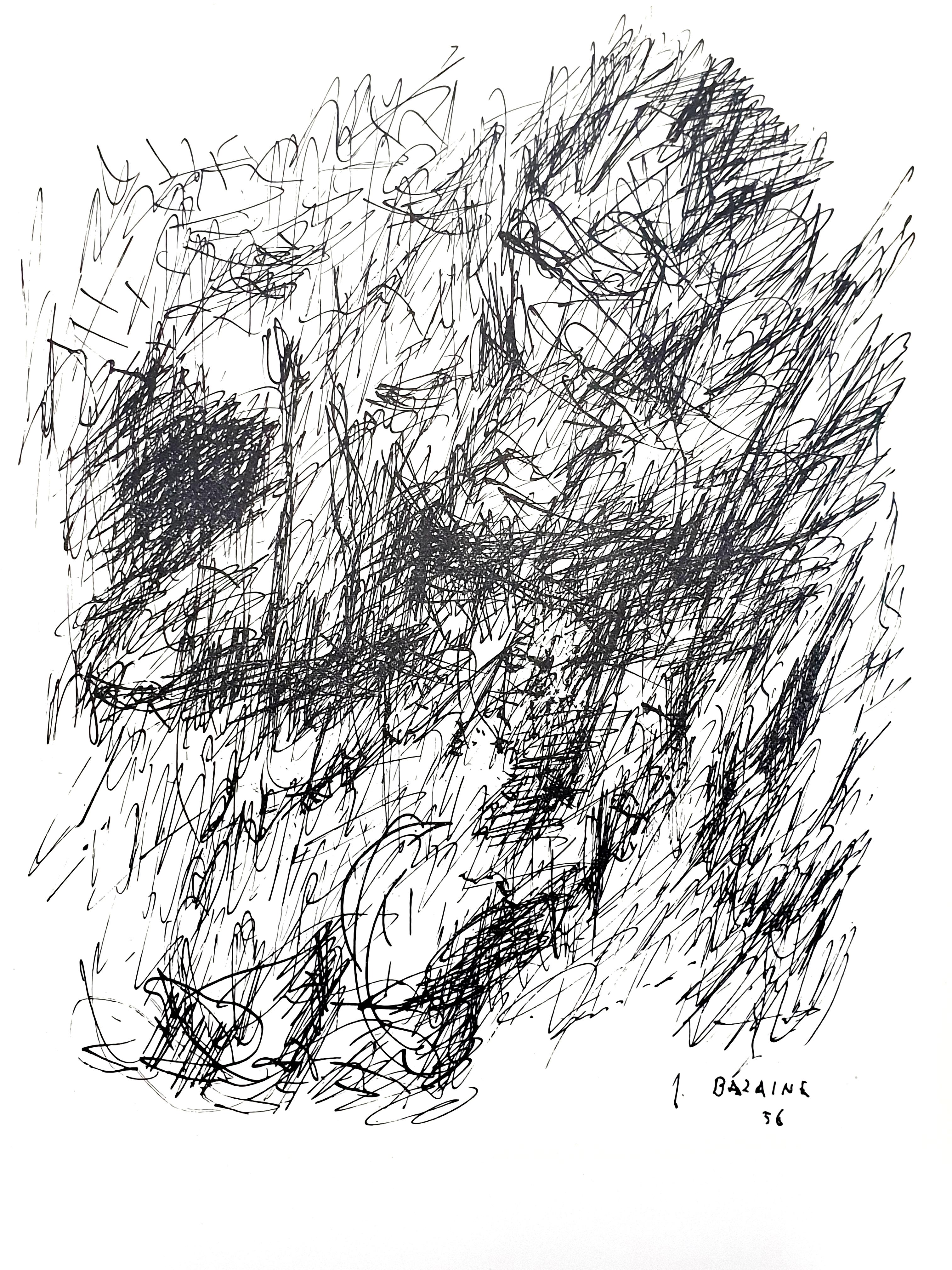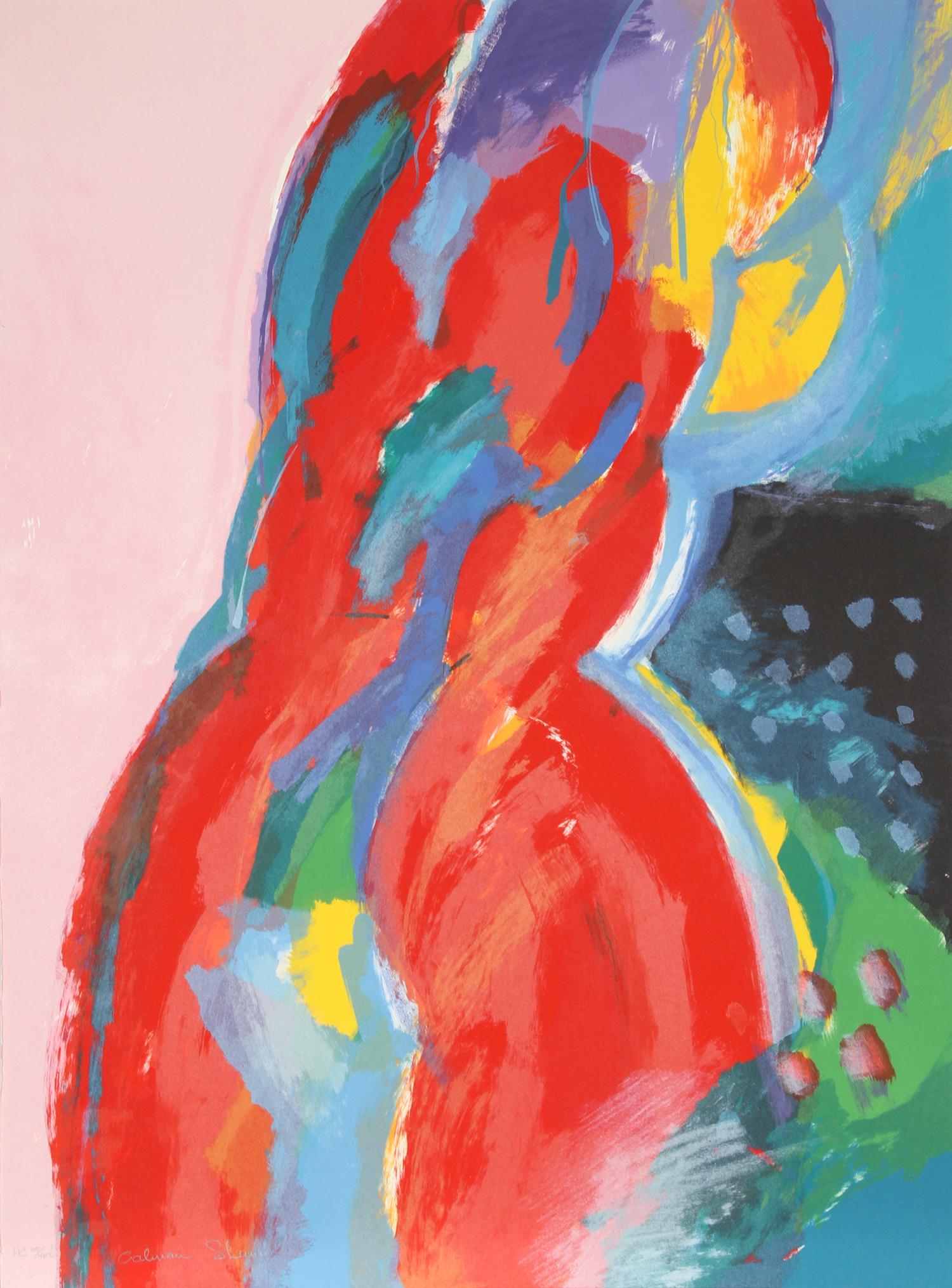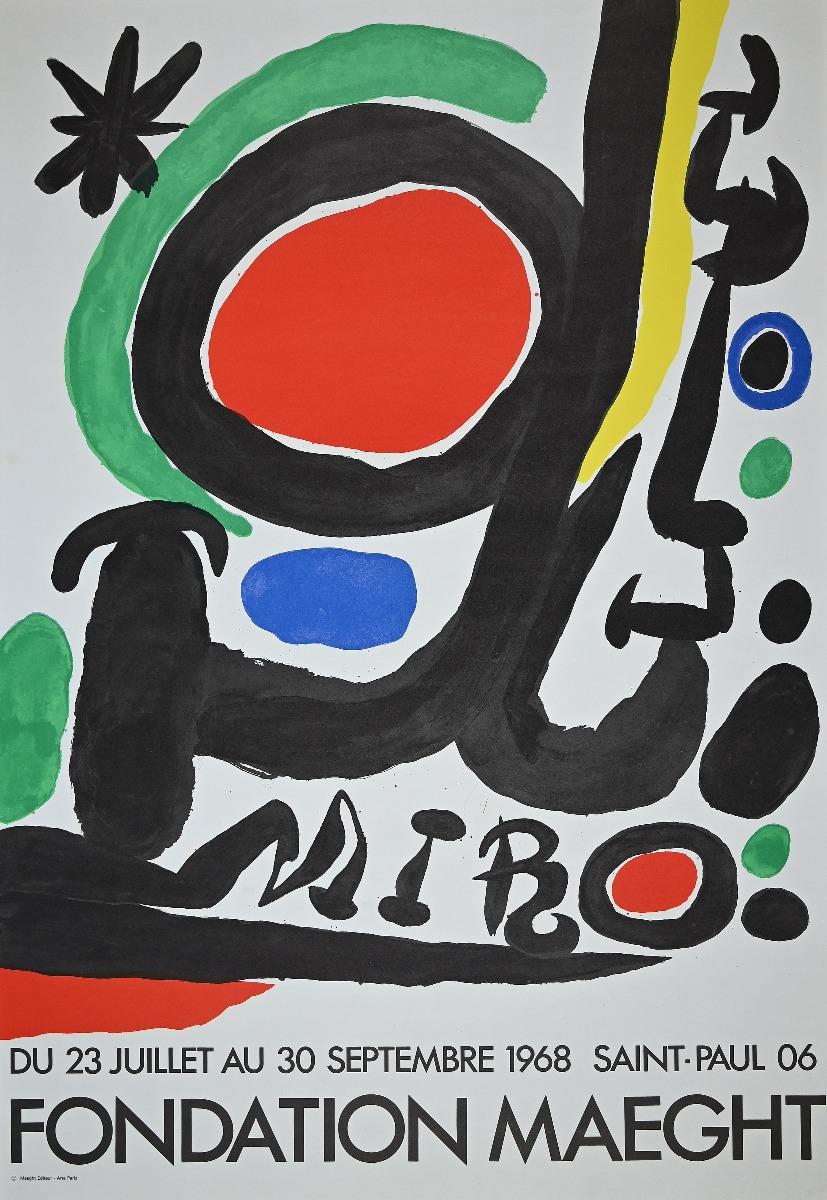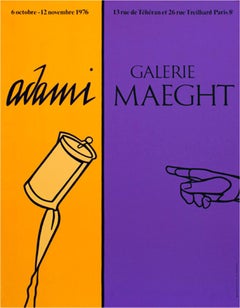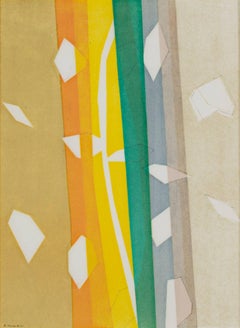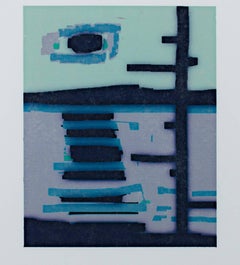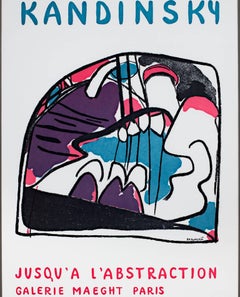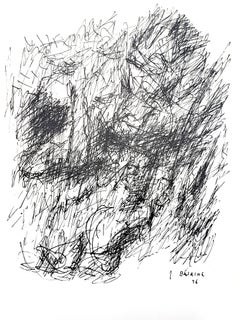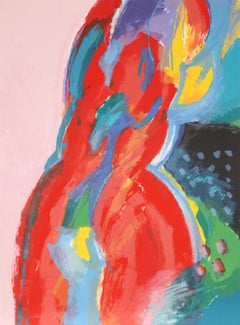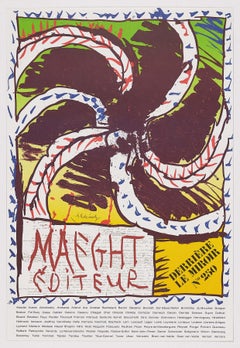Items Similar to "Galerie Maeght, " Graphic Color Lines Lithograph Poster
Want more images or videos?
Request additional images or videos from the seller
1 of 7
"Galerie Maeght, " Graphic Color Lines Lithograph Poster1974
1974
$340
£259.33
€295.31
CA$477.80
A$521.11
CHF 276.05
MX$6,247.39
NOK 3,515.65
SEK 3,214.80
DKK 2,206.27
About the Item
"Galerie Maeght" lithograph poster. This poster holds Bazine's name in harsh orange lines near the top of the piece. Diagonally bisecting the b and a in Bazaine is a teal line. Bellow this horizontally against the white backgrounds are two lines, one painted yellow and the other blue. Unsigned.
Image: 29 x 21 in
Jean Bazaine was a French painter, designer of stained glass windows, and writer. He was the great great grandson of the English Court portraitist Sir George Hayter. In 1949/1950 he had his first major one man show at the Galerie Maeght, who remained his art dealer thenceforth. From then on it was a steady progress of major exhibitions: Bern, Hanover, Zürich, Oslo... 1987 a retrospective exhibition in Galerie Maeght, 1988 a retrospective of his drawings in the Musée Matisse and finally in 1990 the Exposition Bazaine in the Galeries Nationales du Grand Palais, Paris., which was accompanied by the reissue of his major texts on painting in art theory as Le temps de la peinture (Paris, Aubier 1990). "The motley crowds of international tourists and souvenir-shoppers who fill the ancient streets of the Latin Quarter in Paris spend most of their time admiring the open-air displays of seafood outside the Greek restaurants in the rue de la Huchette. They ignore the beautiful church of St Severin in the same street, for have they not already "done" Notre Dame? So they miss one of the most wonderful series of stained-glass windows in France: Jean Bazaine's vivid, dynamic works irradiating the sombre ambulatory and apsidal chapels. These windows represent the seven sacraments of the Church, portrayed as essential forms from nature in all its glory and symbolising Water, Fire and Light, sacred emblems of Divine Grace. An appropriate biblical verse is inscribed beneath each. Only Pierre Soulages with his "luminous black" windows at l'Abbaye de Conques (1998) can stand comparison with the majesty of these contemporary works by Bazaine, created between 1965 and 1970. Bazaine was fortunate in his friends. He received at an early stage in his student career support and advice from another master colourist, Pierre Bonnard. In his youth he knew Leger, Braque, James Joyce and Marcel Proust. One of his great personal friends was Jean Fautrier, with whom he shared his first exhibition in 1930. His work gradually developed as a form of bold tachisme - brilliantly composed but well-controlled "splashes" of sumptuous colour. He rejected the term "abstract" which he considered a denial of the essentially intimate relationships between art and reality. He quoted his friend Braque: "The canvas must efface the idea behind it." In 1941, during the Nazi occupation, at a time when Hitler was destroying many works of modern art, Bazaine had the courage to organise in Paris a first "avant-garde" exhibition of 20 French artists. In 1948, he wrote his first book, an unpedantic, unacademic view of contemporary painting, Notes sur la peinture d'aujourd'hui. He quotes Braque on Cezanne: "He's a painters' painter - other people think it's unfinished." Bazaine, too, reverenced Cezanne: Three lines drawn by Cezanne overturn our whole concept of the world, proclaim the liberty of man, his courage. The great painters have never had any other aims. The painter says: "I exist, therefore you exist. I am free, therefore you are free. Or at least he tries to. It's his one aim in life." After the Second World War, Bazaine produced vast compositions with virtuoso colour structures, mostly with references to nature, like the breathtaking Vent de mer (1949, now in the Museum of Modern Art, Paris) and Orage au jardin (1952, now in the Van Abbemuseum at Eindhoven). His Earth and Sky (1950) is in the Maeght Foundation at Saint Paul de Vence. One of his greatest works, L'Arbre tenebreux (1962), was sold to the Sonja Henie-Niels Foundation in Norway. These enormous, evocative representations of the forces of nature were always preceded by numerous sketches, drawings and colour value notations that are in themselves fascinating insights into the painter's techniques in the production of apparently spontaneous burst of colour and contrasts of movement and subtleties of tone. Bazaine was a natural choice for large-scale architectural and literary collaborations. He made magnificent illustrations for poetry by André Frenaud, René Char and Jean Tardieu: unlike most painters, he was a passionate lover of poetry, and could express the very essence of a poem in an astonishing feat of almost mediumistic artistic insight into the subject. He created the immense mosaic composition for the Unesco building in Paris (1960), as well as decorations for the transatlantic liner France (1962) and the Maison de la Radio (1963). His monumental gift can be found also in more mundane surroundings like the Cluny metro station. But it is as an inspired creator of works enriching the entire history of modern religious art that Bazaine will best be remembered, by believers and non-believers alike: the windows in the church at Asay (1943-47) in Savoie, the façade mosaics (1951) and windows (1954) of the church at Audincourt in the Jura (1954), the church of Villeparisis (1961) and a reception centre at Noisy le Grand (1955). He also devised tapestries, like the Blasons des douze mois (1975). Among his writing on art, there is Exercise de la peinture (1973) and La Temps de la peinture, a collection of all his writings on painting and the arts in general (1985). Jean Bazaine was a great master, but a humble one. He once confessed that he thought of suicide at least three times every day, so in despair did he feel about his work. One of his favourite quotations in Notes sur la peinture d'aujourd'hui comes, surprisingly, from the classicist Jacques Louis David: I would like a painter, at the end of 20 years of work, to begin each new painting in a state of the same indecision as when he started. And as epigraph to his L'exercise de la peinture Bazaine wrote: Linked for 20,000 years - and for just as long in times to come - to the destiny of man, painting has not lost any of its mystery. And this essay cannot hope to explain it. But the explanation is in every one of his paintings." Article Written by James Kirup
- Creation Year:1974
- Dimensions:Height: 29 in (73.66 cm)Width: 21 in (53.34 cm)
- Medium:
- Movement & Style:
- After:Jean Rene Bazaine
- Period:
- Condition:
- Gallery Location:Milwaukee, WI
- Reference Number:Seller: 204d1stDibs: LU60535511092
About the Seller
4.9
Gold Seller
Premium sellers maintaining a 4.3+ rating and 24-hour response times
Established in 1966
1stDibs seller since 2017
453 sales on 1stDibs
Typical response time: 1 hour
- ShippingRetrieving quote...Shipping from: Milwaukee, WI
- Return Policy
More From This Seller
View All"Galerie Maeght, " an Original Color Lithograph Poster by Valerio Adami
By Valerio Adami
Located in Milwaukee, WI
"Galerie Maeght" is an Original Lithograph Poster bu Valerio Adami. This poster was created to advertise Adami's show at the Galerie Maeght in 1976. The print is orange on the left s...
Category
1970s Expressionist More Prints
Materials
Lithograph
20th century colorful abstract lithograph leaves signed
By Andre Beaudin
Located in Milwaukee, WI
"Pour Daniel-Henry Kahnweiler - Falling Leaves" is an original lithograph, printed in 1964 by Andre Beaudin. It includes vertical frames of tan, orange, yellow, green, and gray. It i...
Category
1960s Modern Abstract Prints
Materials
Lithograph
"What Time Does, " Digital Print with Shellac & Chine Colle signed by S. Caporael
By Suzanne Caporael
Located in Milwaukee, WI
"What Time Does" is a digital print with shellac and chine colle signed in the lower right by Suzanne Caporael. It is an abstract print but vaguely references a landscape and uses su...
Category
Early 2000s Abstract Prints and Multiples
Materials
Digital
Jusqu'a L'Abstraction' color lithograph poster Wassily Kandinsky
By Wassily Kandinsky
Located in Milwaukee, WI
"Jusqu'a L'Abstraction" is a lithograph poster by Wassily Kandinsky. This poster depicts abstract forms in purple, pink, blue, and black and was created for the Maeght gallery in Par...
Category
1940s Modern Abstract Prints
Materials
Lithograph
'Stabiles' original lithograph poster after Alexander Calder, Galerie Maeght
By Alexander Calder
Located in Milwaukee, WI
'Stabiles' is a lithograph poster after Alexander Calder and published by Galerie Maeght in 1971. Calder had produced the stones for this lithograph a year earlier in 1970 for a prin...
Category
1970s Abstract Expressionist Abstract Prints
Materials
Lithograph
"Sixieme Biennale de Peinture, " Vintage Lithographic Poster
By Pablo Picasso
Located in Milwaukee, WI
"Sixieme Biennale de Peinture" is an vintage Picasso exhibition poster printed in 1966 by Mourlot. It depicts a Picasso painting from 1965 and advertises a Biennial exhibition of pai...
Category
1960s Cubist Figurative Prints
Materials
Lithograph
You May Also Like
Abstract Composition - Original lithograph poster - Maeght 1956
By Pierre Tal-Coat
Located in Paris, IDF
Pierre TAL-COAT
Abstract Composition
Original vintage lithograph poster
On paper 62 x 48 cm (c. 25 x 19 in)
Edited for the artist exhibition at Maeght Gallery in 1956
Excellent co...
Category
1950s Abstract Abstract Prints
Materials
Lithograph
Jean Bazaine - Original Lithograph
By Jean Bazaine
Located in Collonge Bellerive, Geneve, CH
Jean Bazaine - Original Lithograph
1956
Dimensions: 38 x 28 cm
Revue DLM 10 ans d'éditions
Edition: Maeght
Category
1970s Abstract Geometric Figurative Prints
Materials
Lithograph
Through the Window, Colorful Abstract Lithograph by Calman Shemi
By Calman Shemi
Located in Long Island City, NY
Artist: Calman Shemi, Argentine (1939 - )
Title: Untitled I
Medium: Lithograph, signed and numbered in pencil
Edition: HC 60/450
Size: 34.5 in. x 26 in. (87.63 cm x 66.04 cm)
Category
Late 20th Century Abstract Abstract Prints
Materials
Lithograph
Pierre Alechinsky Derriere le Miroir original poster lithograph Maeght Editeur
By Pierre Alechinsky
Located in Miami, FL
"Pierre Alechinsky (Belgium, 1927)
'Derriere le Miroir, Maeght Editeur',
lithograph on paper
34.7 x 23.7 in. (88 x 60 cm.)
Unframed
Ref: ALE100-201
Pierre Alechinsky
Born in the im...
Category
1970s Abstract Figurative Prints
Materials
Lithograph
The Wheel (Maeght) - Vintage Lithograph Poster, 1982
Located in Paris, IDF
Pierre ALECHINSKY
The Wheel (Maeght), 1982
Lithograph and offset
Printed signature in the plate
On paper 88 x 60 cm (c. 35 x 24 inch)
Created for Maeght / Derriere le Miroir in 1982...
Category
1980s Abstract Abstract Prints
Materials
Lithograph, Offset
Vintage Exhibition Poster at Galerie Maeght - Offset and Lithograph - 1968
By Joan Miró
Located in Roma, IT
Mirò - Fondation Maeght is an original artwork realized after Joan Miró.
Offset and Lithograph.
The artwork was realized in the occasion of the exhibition dedicated to the graphic ...
Category
1960s Surrealist Abstract Prints
Materials
Lithograph, Offset
More Ways To Browse
Vintage French Windows
Robert Mazal
Robert Motherwell Roth Handle
Roland Poska
Rothko Lithograph
Roy Lichtenstein Cathedral
Roy Lichtenstein Imperfect
Ruth Sica
Ryo Tokita
Salvador Dali Lettre
Salvador Dali The Alchemist
Sam Calder
Sam Francis Swatch
Savoy Damien Hirst
Scott Kilgour
Seated Woman Picasso
Shigeo Fukuda
Siri Rathsman
